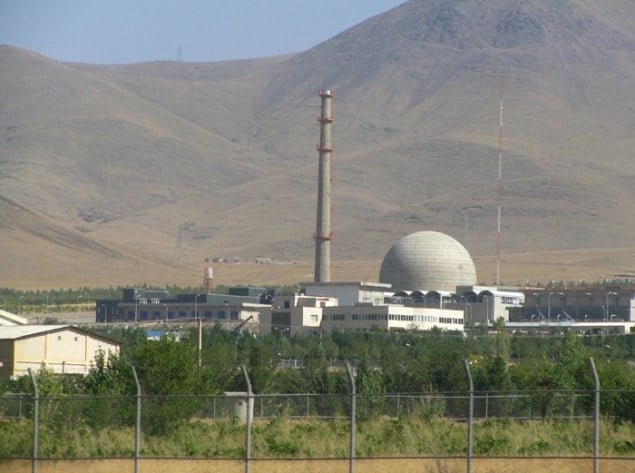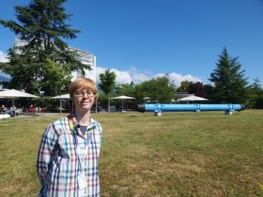
A new system that uses an antineutrino detector to monitor a nuclear reactor for the production of weapons material has been proposed by an international team of physicists. A detector parked close to the facility could fully assess the state of the reactor core by detecting the antineutrinos it emits. However, the researchers admit that current detectors are not up to the job and additional research and development will be needed before their method is viable.
Nuclear power plants can be appropriated to produce plutonium for weapons, and this is why governing bodies such as the International Atomic Energy Agency (IAEA) are looking at developing methods that can be deployed outside a facility to confirm that the reactor’s operations are as declared and that no material has been removed from the site. The idea of using antineutrino detectors as a non-proliferation safeguard for nuclear reactors is not new – it was first suggested more than 30 years ago in 1978 and much research has been carried out since. The method itself is useful, because an operating reactor would generate an enormous number of antineutrinos – on the scale of 1026 per day, from a typical power reactor.
Across the spectrum
But the energy spectrum of the antineutrinos depends on whether they are produced via fission in uranium or plutonium – those from plutonium have a lower average energy. This means that antineutrinos carry with them signature information about the amount and type of fissile material in the reactor core. So, by observing the spectrum, it is possible to determine the relative fraction of fissions that arise from plutonium, and this in turn can be used to work out the amount of plutonium that are in the core. Many studies on using such antineutrino detectors as monitors have been carried out – indeed, one such prototype detector, SONGS1, was installed at the San Onofre Nuclear Generating Station (SONGS) in California in 2003, but the detector was unsuccessful due to its limited design. However, detector sensitivities are still limited, and the entire energy distribution of the antineutrino spectrum from a reactor is unclear.
Now, Patrick Huber from Virginia Tech in the US, along with colleagues in Vienna, Austria, say that neutrino-detector technology has improved vastly in the past 5 years. The team has now combined detailed reactor simulations with state-of-the-art reactor neutrino-flux calculations and a statistical analysis, which they say “fully accounts for the energy distribution of the antineutrinos” and focuses on the IR-40 Iranian heavy-water reactor at Arak. In their latest research, recently published in Physical Review Letters, Huber and colleagues build on their other study of the 1994 North Korean nuclear crisis and suggest that the reactor’s core could have been successfully probed when inspectors were allowed to return.
Based on that work, the team has now analysed the publicly available information on the IR-40 reactor. They suggest using 20 tonnes or less of scintillator in a detector system placed in a standard shipping container and parked just outside the reactor building. “The reactor building of the Arak reactor has a diameter of 32–34 m and the reactor sits at the centre, a few metres above ground,” says Huber. “This makes the distance between the centre of the reactor and the centre of the detector 19 m, if one puts the detector right on the outside of the exterior wall of the reactor building.” This proximity is necessary so that sufficient measurements can be completed within the IAEA’s required time of 90 days, according to the team’s analysis.
Direct detection
Huber told physicsworld.com that the team’s method would allow inspectors to detect fuel removal, even if the monitoring was interrupted for a period – due to technical glitches or diplomatic standoffs – and then restarted. During such an interruption, plutonium-enriched material generated by the reactor could be removed and the reactor could be replenished with fresh uranium fuel. Current methods, including cameras and video monitoring, would not allow inspectors to detect such a substitution, shutting down the reactor and making expensive and lengthy measurements of the core. An antineutrino detector, on the other hand, would allow inspectors to inspect the state of the core after a period of absence, and could also allow the international community to be reassured that fuel has not been removed, according to Huber. “That is one of the key advantages of our method compared with any other means of safeguards,” he says. Also, the proposed system would provide a complete spectrum of reactor antineutrino flux – something that is essential. According to Huber’s analysis, their ideal system could detect as little as 2 kg of plutonium being removed from the reactor.
Above-ground advances
Huber does acknowledge that the researchers’ system still requires significant technological advances. “What we need is a detector that can work at the surface, with a good efficiency, with reasonable energy resolution,” says Huber, pointing out that individually each parameter has been met, but not combined. He also says that if a sterile-neutrino detector is successfully built, then that would also serve perfectly as a safeguard detector.
David Wark, a neutrino specialist at the University of Oxford, acknowledges that the researchers’ case study shows that a detector with realistic capabilities should be able to detect the diversion of interesting quantities of plutonium from a real reactor. However, he also points out that the analysis depends on understanding the shape of the antineutrino spectrum from a reactor, and “deviations between measured spectra and calculations that are as big as the differences this paper is using to distinguish plutonium-239 from uranium-235 have recently been seen by three reactor experiments, which sort of calls into question how well we can reliably model the differences between uranium and plutonium…although that could be checked in advance with known reactors”.
Hopefully, the next five years will determine whether such antineutrino detectors can reliably be used to monitor nuclear reactors.
The research is published in Physical Review Letters.



